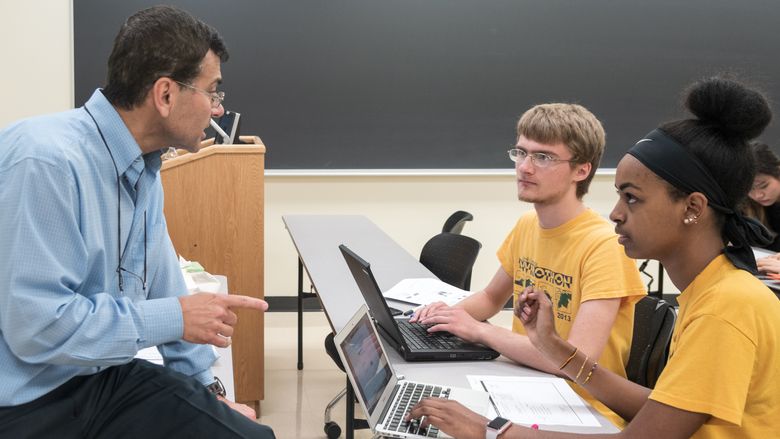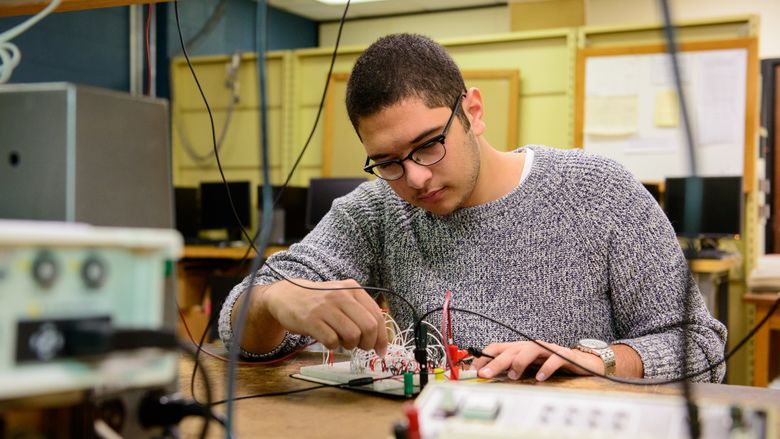
Penn State York students experience Virtual Reality headsets during Biology class.
YORK, Pa. — In the ever-evolving landscape of higher education, Penn State York is emerging as a leader in integrating virtual reality (VR) into the classroom. While many institutions are still experimenting with VR technology, Penn State York has fully embraced its potential, using it across multiple disciplines to enhance learning, engagement and student outcomes.
With 25 VR headsets available, the campus has created a robust ecosystem where students gain hands-on experiences that go beyond traditional learning methods.
Transforming learning through VR: Student and faculty perspectives
Students and faculty alike have recognized the transformative power of VR. One student said, “Overall I really enjoyed the experience and thought it was more entertaining and engaging than working in Zoom breakout rooms.” Another student from Emily Blanke’s class compared the experience to something out of a childhood classic, saying, “It’s like a real-life 'Magic School Bus.'”
Faculty members have echoed these sentiments. Bill Cantor, assistant teaching professor of project and supply chain management and information technology, observed, “Given the choice, I would prefer virtual reality classes over traditional Zoom classes. I noticed a marked increase in engagement levels during the class, which I attribute to the use of VR technology.”
This feedback highlights how VR is not only engaging but also effective in fostering student participation and enthusiasm for learning, he said.
Innovative applications of VR at Penn State York
"Virtual reality is transforming education at Penn State York, creating immersive learning environments that enhance understanding and prepare students for real-world challenges," said Elizabeth Park, Penn State Instructional Designer, who has been instrumental in bringing VR experience to campus. "With early support from Media Commons and the dedication of faculty like Bill Cantor, VR has expanded across business, communications, biology, and human development and family studies.”
Penn State York faculty across multiple disciplines have successfully integrated VR into their curricula, demonstrating the technology’s versatility:
-
Human Development and Family Studies (HDFS): Sonia Molloy's Human Development and Family Studies (HDFS) students participated in an immersive experience called "Traveling While Black," which provided an eye-opening look into racial segregation and social justice. The following week, these students shared the experience with members of the Osher Lifelong Learning Institute (OLLI), fostering intergenerational discussions on important social issues. Molloy’s students were also joined by Sukhdeep Gill’s HDFS class, proving how accessible and impactful VR technology can be in facilitating discussions on race and history.
-
Business and Management: Bill Cantor’s class is using VR headsets to allow students at Penn State York and other Commonwealth Campuses to collaborate in a realistic business environment. Megan Lorenz and Kristine Parkes’ students engage in HR simulations and public speaking exercises using "virtual speech." This technology allows students to practice difficult HR conversations, such as interviews, with AI-generated feedback, enhancing their real-world preparedness.
-
Science and Technology: Emily Blanke’s biology students use "virtual medicine" to explore human anatomy in an immersive way. In each class, students explore various aspects of anatomy through VR, gaining a deeper understanding of the human body. Their studies culminate in a visit to the Milton S. Hershey Medical Center, where they can see real anatomical specimens firsthand. Joe Royer’s students took a virtual tour of Google’s headquarters, providing them with inspiration and insight into potential career paths in tech as they finish their degrees.
The educational benefits of VR
Penn State York is embracing immersive learning experiences through the use of VR in its classrooms, a practice supported by a growing body of research highlighting the effectiveness of VR in fostering meaningful learning. Studies show that VR enhances motivation, improves learning outcomes, and provides an immersive way for students to engage with content. Penn State York’s adoption of VR aligns with these findings, providing students with opportunities to:
-
Engage kinesthetically — Students learn by doing, whether that means manipulating calculus equations with their hands or traveling through the bloodstream as a cell.
-
Enhance teamwork — The sometimes-limited number of headsets encourages collaboration, ensuring students work together to solve problems and complete tasks.
-
Increase motivation — VR gamifies learning, making educational experiences more enjoyable and intrinsically rewarding.
-
Improve learning outcomes — Research indicates that social VR environments promote realistic, cognitively challenging experiences that encourage deeper understanding.
York Immersive Technology Day: A showcase of VR excellence
In February, the campus hosted its second annual York Immersive Technology Day, co-led by Park and Carla Seward from Media Commons. This event brought faculty together to discuss best practices for incorporating VR into their courses, while also giving the entire campus community a chance to try the technology firsthand.
Said Park about the day, “At the second annual York Immersive Technology Day, faculty showcased how they are integrating VR to engage students in experiential learning and complex problem-solving. Their innovation and dedication are inspiring!"
For faculty interested in implementing VR in their courses, Park can serve as a key resource. Contact Park at [email protected] for information and guidance on leveraging this powerful tool for teaching and learning.
Looking ahead: The future of VR at Penn State York
As VR technology continues to evolve, Penn State York remains at the forefront of integrating these tools into higher education. The campus’s dedication to instructional innovation ensures that students receive a cutting-edge education that prepares them for the digital age — and the real world. Whether through social justice explorations, business simulations, anatomy lessons, or career-building experiences, VR is shaping a new educational reality at Penn State York — one that is immersive, engaging and transformational.





